Kingston turnpike house
Kingston turnpike house
and Kingston Gate
In 1753, Turnpike Commissioners were appointed for "repairing and widening the roads" of Yeovil. At the first meeting of the Yeovil Turnpike Trust on 12 June 1753, they ordered that "three capital gates be erected" at Hendford Bridge (by today's Railway Tavern) and also known as Hendford Gate, Goar Knap (spanning Sherborne Road on the town side of the junction of St Michael's Avenue - later replaced by Yeovil Bridge Turnpike House) and the "Head of Kingston". There was also the Pen Style Stop Gate near the entrance leading from Pen Style to Newton, later replaced by Pen Style Turnpike House. Other gates at various times being Watercombe Side Gate, Combe Street Lane "Hutt Gate" - later replaced by Mudford Road Turnpike House, Milford Lane Side Gate (today's Goldcroft) and Jernegan's Hut Side Gate at Vagg.
Richard Slade was elected Collector of Tolls at Kingston Gate and, in common with the other collectors, he was paid a "salary of 6 shillings per week, or 8 shillings until the completion of the house."
In 1754, the Clerk was ordered to apply to a Justice of the Peace for warrants against a Yeovil man and a Martock man "to recover the penalty of twenty shillings for giving and receiving a ticket to evade payment of the toll at Kingstone Gate".
In 1770, the tolls of Kingston Gate were let to Philip Francis for £200 (around £35,000 at today's value). By 1785 the tolls were let at £241 (around £40,400 at today's value) for the year.
On 25 January 1781 the Town Commissioners ordered "that an engine for weighing carts, waggons and carriages with goods or merchandise be erected at the Kingston Gate according to the Act of Parliament made for that purpose in the thirteenth year of his Present Majesty's reign and that Mr Cox do send the person at Frome who erected an engine for Mr Withers at Crewkerne, to know his terms and cost of same." The engine was erected and first used on 28 May 1781, the gatekeeper being empowered "as an encouragement to his attention and care of the roads to take three pence a carriage, but not less" for weighing them.
In 1794 passengers had experienced great inconveniences by the erection and use of an engine for sawing marble, set up on the footway adjoining the turnpike in Kingston, and by blocks of marble being laid on the footway. He was ordered to remove the nuisance or be prosecuted.
E Watts' map of 1806, illustrated below, clearly shows the gate across the road and a gatekeeper's hut next to it, actually situated in the road.
During the annual letting of toll gates of the 1820s and 1830s, the Kingston Gate invariably included the Combe Street Lane Side Gate and the Milford Lane Side Gate.
It was named Kingstone gate in the 1841 census and houses opposite were referred to as "Mr Mayo's houses, opposite Kingston gate". It was named simply as "the Turnpike Gate" in the 1851 census. It was also in the 1841 census that the Kingston turnpike gate was referred to as Ram Park Gate.
In 1852, in his Report to the General Board of Health concerning, among other items, the condition of Yeovil's roads, Thomas Rammell wrote “The Turnpike roads of the parish are under the management of trustees called the Yeovil Turnpike Trust, and are repaired by their own Surveyor. About £60 annually are expended on the bye-roads of the parish without the town. Toll gates are situate at all points round the town, but not so as to interfere in any way with its traffic.” At this time the toll paid for a horse not drawing was 1½d and drawing, that is, pulling a cart or suchlike, was 4½d (58p and £1.73 in 2017's value).
A new tollhouse was built for the toll collector by Kingston Gate, where Fiveways Roundabout is today, probably in 1856. When the Yeovil Turnpike Trust was abolished in 1875 the tollhouse was taken down stone by stone and re-erected about a hundred yards further down Kingston. At the same time all of Yeovil’s toll gates, stop gates and side gates were removed.
|
Yeovilians remember... In a letter published in the Western Gazette in March 1930 an un-named Yeovilian recalled the tollhouse of fifty years previous "Memory also recalls the old turnpike gates stretching across the road at the junction of the three main roads leading into town near the old hospital. Three sets of double wooden gates spanned the road at this point. Wicket gates at each side of the road were provided for the use of pedestrians. A large bell was affixed to the gates enabling the drivers of vehicular traffic to draw attention of the toll-gate keeper to unlock the gates and, after paying their toll, to let them pass on. Many boyish pranks we played on dark nights with that old bell to the annoyance of the old gate-keeper. The toll house in which the keeper lived stood in the corner, where now stands a brick outhouse used by the occupants of the two cottages at the bottom of Mudford Road. Shortly after the passing of the Turnpike & Roads Act in 1878, the gates were abolished; the old toll-house pulled down and the stones used in building the house, 23 Kingston, in which Mr Burrows lives at present." |
The Kingston Turnpike House was demolished for the second and final time in 1969 when Kingston was widened and the site was cleared for the construction of Yeovil District Hospital.
maps
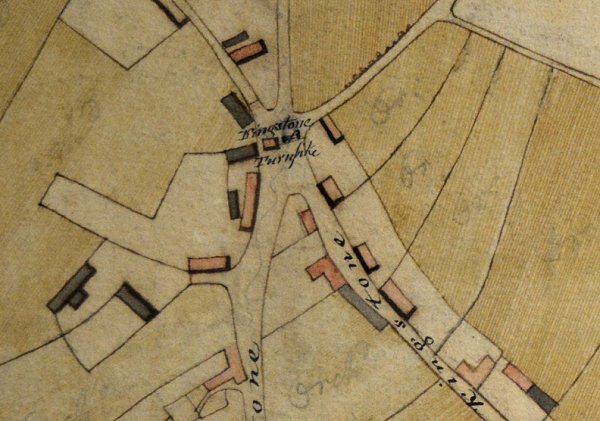
E Watts' map of 1806 clearly shows the gate across the road and a gatekeeper's hut next to it, actually situated in the road.

An enlargement of the previous 1806 showing the Kingston Turnpike gate in greater clarity.

Kingston Toll Gate shown in the 1842 Tithe Map.
gallery

The notice placed in the Western Flying Post during 1837 requesting tenders for the building of the new toll houses at Hendford Hill and Kingston Gate.
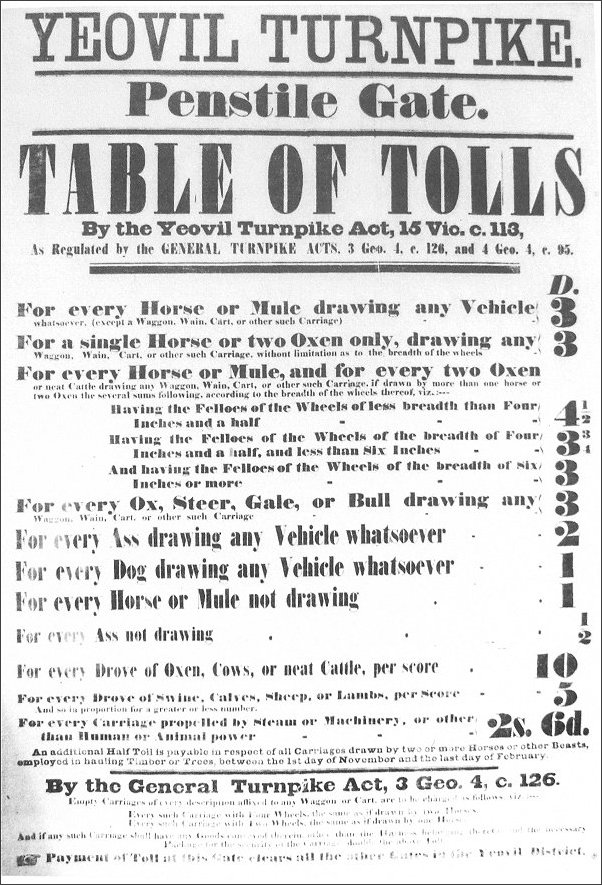
Yeovil Turnpike Trust toll charges of 1852 - in this instance for Penstile, but the same charges would have applied to Kingston.
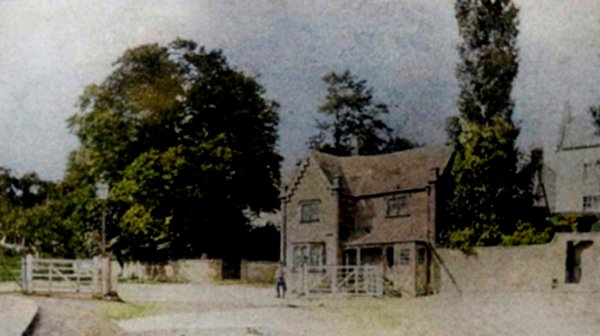
This
colourised photograph
features in my
book 'Yeovil From Old Photographs'.
The second (at least) Kingston Turnpike House photographed about 1860 by Henry Goodfellow (before the Fiveways hospital was built). Notice the gates which would close until tolls had been paid. The house was moved a hundred yards further down Kingston in 1875.
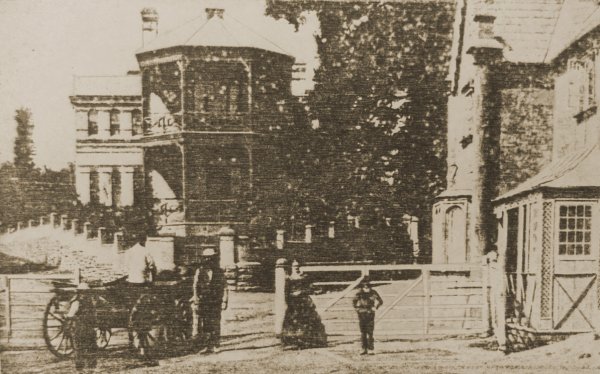
Photographed by Thomas Clarke between May and December 1874 from Kingston, and showing the new Fiveways Hospital and the Kingston Toll Gates. This is probably the earliest photograph of the new hospital that had opened just two years earlier, in January 1872.

This colourised
image features
in my book 'Yeovil
- The Postcard
Collection'.
A postcard dated 1906 looking along Kingston towards the town. The building at extreme left is the Kingston Turnpike House, then comes the entrance gateway in the garden wall of the Unitarian chapel before the three-storey villas. The Duke of York (before it was rebuilt) is seen at extreme right.

Kingston Turnpike House in a colourised photographed of the 1960s.
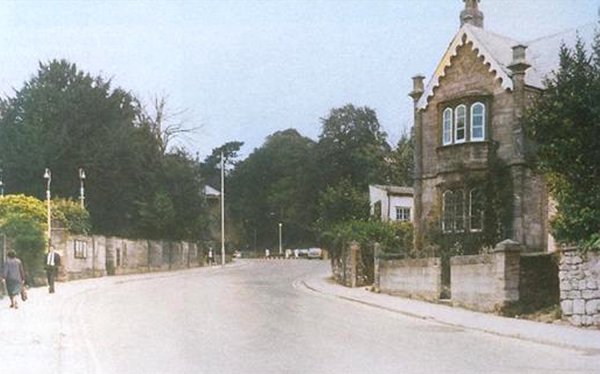
Kingston Turnpike House (east side) in its new location, in a colourised photographed of 1967. At centre is the Fiveways roundabout.